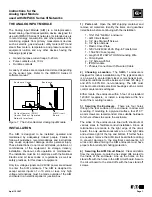
CEDAR Duo – declickle and auto dehiss
33
Decrease the amount of attenuation from -40.0 to 0.0, at which point you will hear that the
processed signal is identical to the unprocessed signal. This is because the Attenuation control is
limiting the amount of noise removal to 0dB - i.e. there is no effect.
Now increase the amount of Attenuation as defined by the material and your taste. You may
find that, if the Bias is too high, you can only increase the Attenuation by a few dBs before the
signal starts to sound muffled. If the Bias is too low, you can have more Attenuation, but with
reduced effect.
Iterating the Procedure
You may now wish to attempt to find a better value for the Bias. Having done this you will
probably wish to modify the LF Bias and Attenuation values further. Fine-tuning of these
controls will lead to excellent noise removal with few or no side-effects. However, the Duo is not
a magic wand, and it may not be possible to restore some badly degraded material beyond a
certain point. Experience will enable you to judge whether you have removed as much noise as
possible without unacceptable consequences.
Noise Reduction in M-S Mode
Our research has shown that it is sometime beneficial to perform noise reduction in M-S mode.
This means that, instead of adjusting the Level (or Bias), LF Bias and Attenuation values
independently for the left and right channels, you may adjust them for the monophonic content
within the signal (M) and for the content that is only present in the left or right channels (S).
Signal with a high Mid (M) noise component
If you perceive that the worst of the noise is coming from the centre of the stereo image, place
the auto dehisser in M-S mode. Now toggle the M-S button so that you are adjusting the S
component only, and reduce the Attenuation to zero. Toggle again so that you are adjusting the
M component only. You are now performing noise reduction on the centre of the stereo image.
Follow the tutorials above, and listen to the effect that this has. You will find that you can apply
a considerable amount of noise reduction on the M component without affecting the perceived
width or ambience of the wanted signal.
Signal with a high Side (S) noise component
Sometimes, you will find that loud, wanted signals in the centre of the stereo image mask the
noise, so that it is only noticeable at the sides of the image. Again, this can be handled
effectively in M-S mode. Toggle the M-S button so that you are adjusting the M component only,
and reduce the Attenuation to zero. Now toggle again so that you are adjusting the S
component only. You are now performing noise reduction on the sides of the stereo image.
Follow the tutorials above, and listen to the effect that this has. You will find that you can apply
a considerable amount of noise reduction without affecting the wanted signal at the centre of
the soundstage.








































